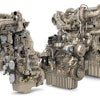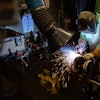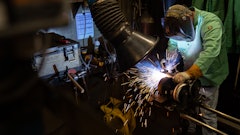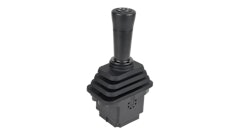To help ensure safe landings on airport runways, it is critical to remove the rubber build-up from runway surfaces, exposing the original pavement and restoring the friction coefficient to desired levels for maximum braking on wet surfaces.
Over time, the skid resistance of an airport's runway pavement deteriorates due to a number of factors. The primary ones are the mechanical wear and polishing action from aircraft tires rolling or braking on the pavement and the accumulation of contaminants, chiefly rubber, on the pavement surface.
Other influences are local weather, the type of pavement, the materials used in original construction, any subsequent surface treatment and airport maintenance practices.
During aircraft landing, prior to the actual touchdown, the tires are at rest, experiencing no rotation. At the point of impact with the asphalt, the aircraft is moving at a speed of 100 knots (115 mph), so the tires must reach a rotational speed to match the aircraft speed in an extremely short amount of time. This causes superheating of the tires, as well as skidding, which leaves rubber deposits on the runway. The tires also leave rubber deposits while braking when the aircraft is coming to a stop after touching down. Heavy rubber deposits can cover the pavement surface texture causing loss of aircraft braking capability and directional control, particularly when runways are wet.
Additionally, removing conflicting or obsolete markings is also important to ensure that correct routes are followed to minimize risk of accidents and to promote the efficient movement of aircraft and ground support equipment to maintain tight schedules.
Historically, removing pavement markings from airport runways and roads involved grinding the surface down to the lowest level of the paint, thermoplastic, epoxy or preformed tape. The problem with this method was that it removed up to half an inch of the surface, depending on the depth of the marking being removed.
Meet the hog
Established in 1988, Waterblasting Technologies, Stuart, FL, makes mobile waterblasting equipment for the removal of all types of durable traffic markings from asphalt and concrete surfaces. The design team used their experience with high-pressure water pumps to develop the Stripe Hog line of marking removal systems using a 40,000 psi waterblasting and vacuum system to remove markings without damaging the runway surface.
The Stripe Hog 4000 does its work with a zero-turn John Deere turf tractor that features an onboard hydraulic system. The blasting head is offered in widths of 6 to 14 in. and is capable of removing up to 7,500 linear feet an hour. The standard tank comes with 1,900 gal. of stainless steel water supply and 1,600 gal. of debris storage.
The Stripe Hog 4000's articulated boom utilizes helical, hydraulic rotary actuators manufactured by Helac Corp., Enumclaw, WA, to position the blast head with precision, thus enabling more efficient marking removal.
The boom is triple-jointed with two vertically mounted Helac L20-4.5-E-FT-180 rotary actuators for side-to-side boom rotation and one horizontally mounted L20-4.5-E-FT-180 rotary actuator for up and down boom positioning.
Eliminating hydraulic cylinders and switching to Helac's rotary actuators proved profitable for Stripe Hog operators. They experienced a productivity gain of 30% due to the elimination of backlash and providing better head placement control resulting in a $1,440 increase in profits per 40-hour work week.
Damage control
The Stripe Hog offers a compelling new methodology for removing markings via its self-contained removal and debris collection system. As Steve Carroll, chief engineer, Waterblasting Technologies points out, the Stripe Hog "is quick, clean and easily adapted to the pavement maintenance needs of today's major airports. The Stripe Hog is capable of removing markings from the pavement while causing only minimal damage to the surface."
Marking removal methods such as grinding cause significant damage to paved surfaces, and also requires additional crew and machinery to clean up the debris. This translates into an expensive process in terms of people, machinery and fuel costs.
Other methods to clean runways include the use of detergent cleaners and brush scrubbing systems or abrasive sand blasting which aren't as efficient as water blasting.
Innovative solutions
One of the key challenges the engineering team at Waterblasting Technologies faced was determining how to effectively replace their original hydraulic cylinder and linkage system used to position the waterblasting and reclamation tool to overcome drift, slop, lack of durability and user complexity.
To solve this design dilemma, Waterblasting Technologies turned to Helac for assistance. Carroll explains that "Helac's helical, hydraulic rotary actuators brought us to a new level of perfection. We have gained a competitive advantage in the marketplace, and Helac helped us launch our next generation products.
"We plan to incorporate Helac's actuators into our designs for future products. We have noted that by using actuators instead of hydraulic cylinders with linkages and bushings, we're spending 50% less time machining and assembling the boom."
According to Carroll, the key benefits of using rotary actuators to position the articulated boom are:
Precision and control: The rotary actuators are able to hold selected positions without drift. All sealing occurs against smooth cylindrical surfaces effectively eliminating all internal bypass and external leakage. The rotary actuators are critical to ensuring the operator of the Stripe Hog can maintain a smooth consistent line in order to remove the pavement marking correctly the first time.
The L20-4.5-E-FT-180 actuators function as a rotating device, mounting bracket and bearing all-in-one. The actuators support 1,100 lbs. of thrust and provide 22,500 in.-lbs. of moment capacity. Yet for all this tremendous power generation, the actuators only weigh 28 lbs. each, with counterbalance valves. Due to the high torque output from a compact actuator, Waterblasting Technologies was able to lengthen the boom assembly, giving the equipment operator greater reach than was possible previously.
Durability: The removal of runway markings creates an extremely abrasive environment due to tar, sand, gravel, rubber, paint and more. With the hydraulic cylinder-based boom positioning system, breakdowns occurred about every 200 hours. If repairs were not made, the boom suffered from drift, making it difficult to keep the blasting head on the desired path.
Because all of the actuator's moving parts are fully enclosed, the ingress of debris into the hydraulic system was eliminated.
Helac's rotary actuators are designed with integral composition bearing and have the capability of carrying tremendous radial, thrust and moment loads because all gear teeth remain engaged at all times. Accordingly, loads are evenly distributed over all gear teeth, giving the actuator exceptional strength.
Ease-of-use: With three rotary actuator pivot points offering 180 degrees of smooth rotation on the boom, the equipment operator has exceptional dexterity in positioning the waterblasting head while working in a variety of spaces including line removal in any position, removal from barrier walls, or lines within 8 in. of a parked car.
Additionally, the use of three actuators permits easy stowing of the boom during transport so that the operator can drive the Stripe Hog right onto the truck, there is no need for trailers or supplemental transport equipment.
Helical actuator technology
The Helac helical actuator is comprised of an outer housing and two moving parts: a central through shaft and an annular piston. Integral with the housing is a ring gear that engages matching helical spline teeth on the outside diameter of the piston.
The inside diameter of the piston carries a second set of helical gears that engage matching splines machined on the shaft. The piston is hydraulically sealed against the housing and the shaft.
As hydraulic pressure is applied, the piston is displaced axially within the housing, while simultaneously the gearing on its outside diameter and housing's ring gear force the piston's rotation. At the same time, the gearing on the inside diameter of the piston and the shaft force the rotation of the shaft. Together, the two sets of gears compound the rotation of the shaft (e.g., the rotation of the shaft is about twice that of the piston).
Looking forward to the future
The market for maintaining the pavement in and around airports looks strong and Waterblasting Technologies expects to participate aggressively in this sector.
Nate Fulton is a marketing specialist for Helac Corp.















